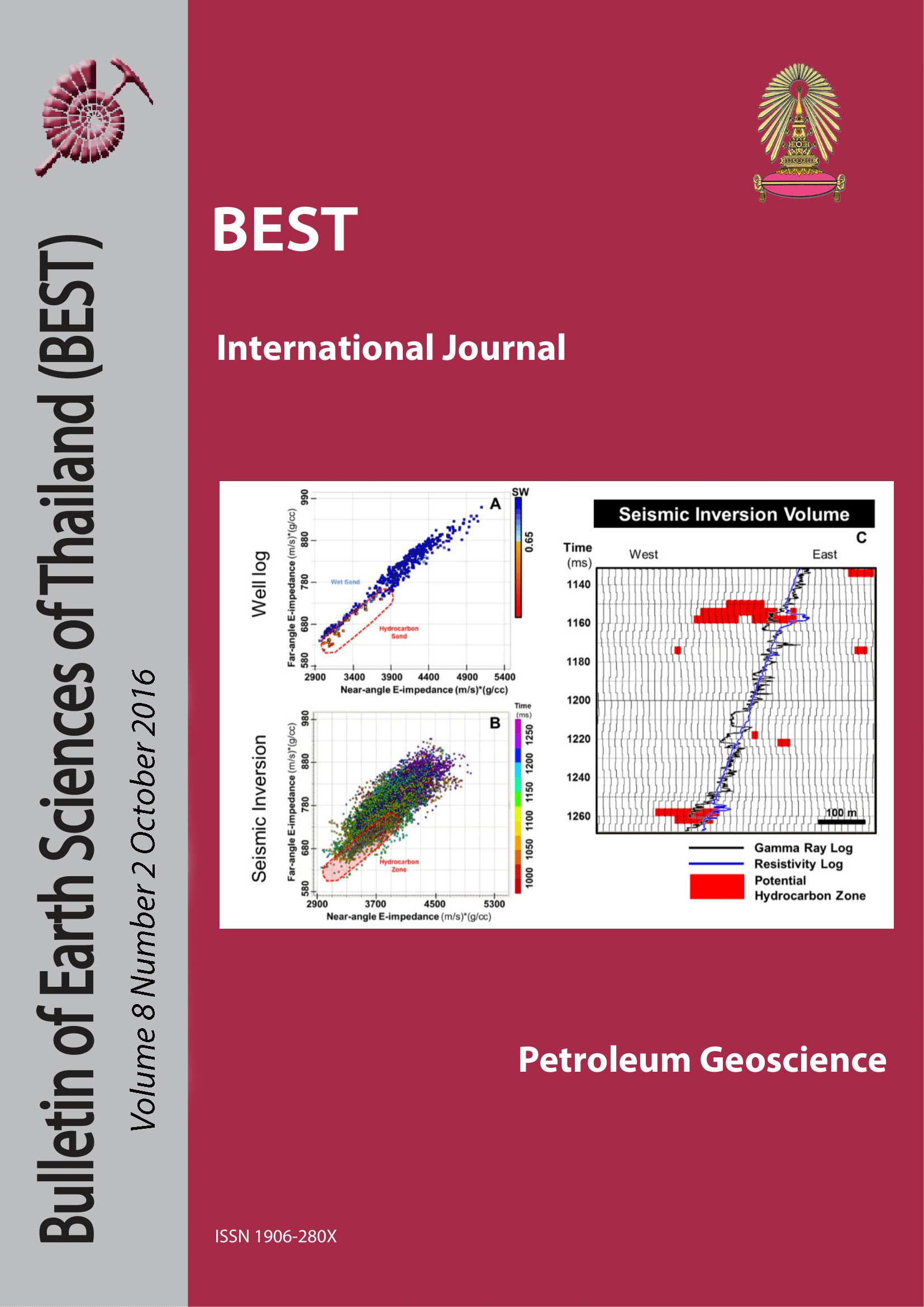POROPERM CONTROLS IN AN “ORDOVICIAN” FRACTURED CARBONATE RESERVOIR IN THE SUPHANBURI BASIN, WESTERN THAILAND: USING A COMBINATION OF CUTTINGS, ISOTOPES AND FMI
Main Article Content
Abstract
Fractured carbonate reservoir is a new hydrocarbon target in the “A area,” which is located in the north-western part of the Suphanburi basin, western Thailand. Based on study of cutting chip samples from this newly recognized basement reservoir interval in well A-01, this producing zone be an interval of fractured and brecciated marble. It is not made up of Ordovician limestone, as was previously inferred. This study uses a combination of petrographic analysis, XRD analysis and carbon-oxygen isotope analysis, combined with image log (FMI or CMI) reinterpretation. Implications, in terms of reservoir quality, are discussed and relationships between subsurface and outcrop are defined. Reservoirhosting fractured marbles show a dominant NNE-SSW fracture direction, which is directly related to a measured minor fracture trend seen in outcrop. C-O isotope crossplots define three trends, related to increasing metamorphic grade and subsequent uplift. Trend 1 is a lower temperature burial trend representing a set of deep meteoric fluids contaminating marbles located near fissures in the very early stages of Paleogene uplift. Trend 2 is an older trend than trend 1 and is tied to increasing burial tem-peratures of the late mesogenetic burial or metamorphic realm. Trend 3 is the youngest, and is related to entry of typical (soil-gas enriched) telogenetic fluids during Tertiary-age uplift. Trend 3 samples are associated with the development of reservoir-grade secondary porosity. In terms of total rock volume, trend 2 dominates the rock fluid signature. This suggests that the likelihood of porosity storage and permeability in the rock matrix is very low. Productive storage will be found in uplift-related solution-enhanced fissures or late-stage fractures and fault-related breccia haloes
Article Details

This work is licensed under a Creative Commons Attribution-NonCommercial-NoDerivatives 4.0 International License.
Copyright © 2008 Department of Geology, Faculty of Science, Chulalongkorn University. Parts of an article can be photocopied or reproduced without prior written permission from the author(s), but due acknowledgments should be stated or cited accordingly.
References
Bunpitaksakul, T., 2016, Poroperm controls in outcrop analogs for Ordovician fractured carbonate reservoir in the Suphanburi Basin, western Thailand, M.Sc research report, Chulalongkorn University, Bangkok, Thailand
DMR, 2014a, Boundary Classification for Geological and Minerals Resources Management, Suphanburi Province, Department of Minerals Resources, p. 111.
F. Hirsch, K. Ishida, T. Kozai, and A. Meesook, 2006, The welding of Shan-Thai: Geosciences, v. 10, p. 195-204.
Glumglomjit, S., 2010, Petroleum potential assessment of the Chonnabot prospect in northeastern region of Thailand, M.Sc thesis report School of Geotechnology Institute of Engineering Suranaree University of Technology., Nakhon Ratchasima, Thailand.
Kaewkongkaew, K., N. Phien-wej, T. Harnpattanapanich, and C. Sutiwanich, 2013, Geological Model of Mae Tang-Mae Ngad Diversion Tunnel Project, Northern Thailand: Open Journal of Geology, v. 03, p. 340-351.
Kloos, J. K., and M. Razlan, 2015, Structural Analysis of Compact Micro-Image (CMI) Data: Well BTI-D01(DA), Interval 2038.80 - 2526.20 m, Ban Don Talai Area, Weatherford Industries.
Lacassin, R., H. Maluski, L. P. Herve, P. Tapponnier, C. Hinthong, K. Siribhakdi, and A. Charoenravat, 1997, Tertiary diachronic extrusion and deformation of western Indochina: Structural and 40Ar/39Ar evidence from NW Thailand: Geophysical Research, v. 102, p. 10013-10037.
Morley, C. K., 2006, Structural geometry and evolution of the Suphan buri, Internal report. PTT Exploration and Production Co., Ltd.
Nazrul, M., 2015, Fluid evolution through different deformation stage: a carbonate outcrop-based study in the western highland of Thailand, M.Sc research report, Chulalongkorn University, Bangkok, Thailand.
O’Leary, J., and G. S. Hill, 1989, Tertiary basin development in the Southern Central Plains, Thailand: Proceeding of the International Conference on Geology and Mineral Resources of Thailand, p. 1-8.
Polachan, S., S. Pradidtan, C. Tongtaow, S. Janmaha, K. Intarawijitr, and C. Sangsuwan, 1991, Development of Cenozoic basins in Thailand: Marine and Petroleum Geology, v. 8, p. 84-97.
Promsen, P., 2016, Poroperm controls in carbonate reservoir, Sin Phuhorm field, NE Thailand using a combination of cuttings, isotopes and FMI, M.Sc. research report, Chulalongkorn University, Bangkok, Thailand.
Ronghe, S., and K. Surarat, 2002, Accoustic impedence interpretation for sand distribution adjacent to a rift boundary fault, Suphan Buri Basin, Thailand, AAPG Bulletin, p. 1753-1771.
Smith, M., S. Chantraprasert, C. K. Morley, and I. Cartwright, 2007, Structural geometry and timing of deformation in the Chainat duplex, Thailand: Geological Society, London, Special Publications, v. 290, p. 305-323.
Warren, J. K., C. Morley, T. Charoentitirat, I. Cartwright, P. Ampaiwan, P. Khositchaisri, M. Mirzaloo, M. Nazrul, A. Panthong, and J. Yingyuen, 2016, Poroperm Evolution through Different Deformation Stages: Stable Isotopes Define Fluid Evolution in Permian and Older Carbonates in Thailand, AAPG Geosciences Technology Workshop, Characterization of Asian Hydrocarbon Reservoirs, Bangkok, Thailand, p. 37.
Warren, J. K., C. Morley, T. Charoentitirat, I. Cartwright, P. Ampaiwan, P. Khositchaisri, M. Mirzaloo, and J. Yingyuen, 2014, Structural and fluid evolution of Saraburi Group sedimentary carbonates, central Thailand: A tectonically driven fluid system: Marine and Petroleum Geology, v. 55, p. 100-121.
Warren, J. K., 2016, Meta-evaporites, Evaporites: A Geological Compendium, Springer International Publishing Switzerland, p. 1375-1468.


